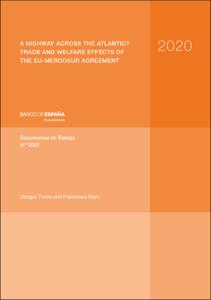A highway across the Atlantic? Trade and welfare effects of the EU-Mercosur agreement
Autor
Fecha de publicación
23-jul-2020
Descripción física
41 p.
Resumen
En este estudio analizamos el acuerdo comercial entre la Unión Europea (UE) y el Mercado Común del Sur (Mercosur), y predecimos sus efectos sobre el comercio y el bienestar utilizando un modelo de gravedad estructural de equilibrio general. En un primer paso, estimamos el incremento en los flujos comerciales generado por los tratados que son similares al acuerdo alcanzado entre la UE y el Mercosur, en un modelo de equilibrio parcial. En una segunda fase, el aumento estimado del comercio se transforma en reducciones en los costes comerciales bilaterales y se imputa a las parejas de países pertenecientes a la UE y al Mercosur para calcular los efectos de equilibrio general del acuerdo en términos de creación y desviación de comercio, y de bienestar. Nuestros resultados indican que es probable que el acuerdo entre la UE y el Mercosur tenga un impacto positivo en el comercio y el bienestar de ambos bloques regionales, aunque con una heterogeneidad sustancial entre las dos áreas y dentro de ellas.
In this paper we analyze the EU-Mercosur agreement and predict its effects on trade and welfare using a general equilibrium structural gravity model. First, we estimate the increase in trade flows generated by trade agreements that are similar to the EU-Mercosur one, in a partial equilibrium setting. In a second step, the estimated increase in trade is mapped into reductions in bilateral trade costs and imputed to EU-Mercosur country pairs to compute the general equilibrium effects of the agreement in terms of trade creation, trade diversion, and welfare effects. Our results indicate that the EU-Mercosur agreement is likely to have a positive impact on trade and welfare of both regional blocs, although with substantial heterogeneity both between and within the two areas.
In this paper we analyze the EU-Mercosur agreement and predict its effects on trade and welfare using a general equilibrium structural gravity model. First, we estimate the increase in trade flows generated by trade agreements that are similar to the EU-Mercosur one, in a partial equilibrium setting. In a second step, the estimated increase in trade is mapped into reductions in bilateral trade costs and imputed to EU-Mercosur country pairs to compute the general equilibrium effects of the agreement in terms of trade creation, trade diversion, and welfare effects. Our results indicate that the EU-Mercosur agreement is likely to have a positive impact on trade and welfare of both regional blocs, although with substantial heterogeneity both between and within the two areas.
Publicado en
Documentos de Trabajo / Banco de España, 2023
Materias
EU; Mercosur; Trade agreement; Structural gravity; General equilibrium; Acuerdo comercial; Gravedad estructural; Equilibrio general; Unión Europea; Comercio internacional; Cooperación e integración económicas; Modelización econométrica; Países de la UE; América Latina
Aparece en las colecciones:












